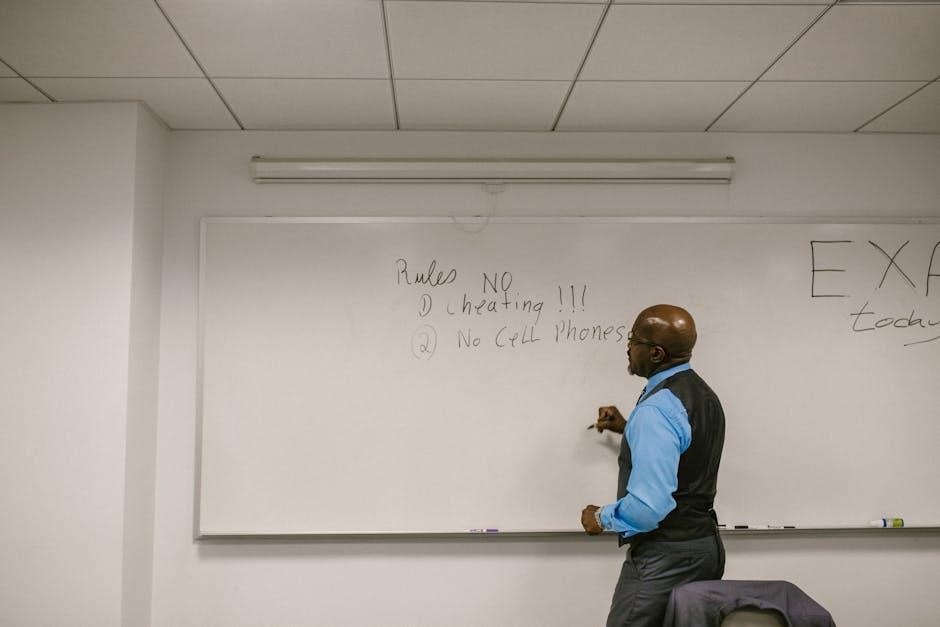The Rules Cyclopedia PDF is a comprehensive guide for Dungeons & Dragons, consolidating rules for character creation, magic, combat, and more into a single, user-friendly reference.
1.1 Overview of the Rules Cyclopedia
The Rules Cyclopedia is a comprehensive guide for Dungeons & Dragons, consolidating rules for character creation, magic, combat, and more into a single, user-friendly reference. It spans levels 1 to 36, offering detailed sections on ability scores, races, classes, and spell progression. Designed for both experienced players and newcomers, it provides clear explanations and organized layouts, making it an essential tool for understanding the game’s mechanics and enhancing gameplay. This PDF serves as a complete resource, covering everything from basic principles to advanced options.
1.2 Importance of the Rules Cyclopedia in D&D History
The Rules Cyclopedia holds a significant place in D&D history as it consolidated the BECMI (Basic/Expert/Companion/Master/Immortal) rules into a single, accessible volume. This milestone streamlined gameplay, making it easier for players and DMs to reference rules without flipping through multiple books. Its comprehensive nature, covering levels 1 to 36, solidified its role as a foundational text for understanding D&D mechanics. The Cyclopedia is celebrated for its clarity and organization, making it a cornerstone of both classic and modern OSR (Old School Revival) gaming, bridging the past and present of the game.
1.3 Structure and Organization of the PDF
The Rules Cyclopedia PDF is meticulously organized, with clear chapters and subheadings that enhance accessibility. It begins with character creation, detailing steps like rolling ability scores and choosing races/classes. Subsequent sections cover magic, combat, monsters, treasure, and worldbuilding, each with specific guidelines. The PDF includes comprehensive tables, spell descriptions, and monster statistics, ensuring quick reference for DMs. Its logical flow from basic to advanced rules makes it a versatile tool for both new players and seasoned veterans, providing a seamless experience for learning and gameplay.

Historical Context of the Rules Cyclopedia
The Rules Cyclopedia was published after the BECMI boxed sets, consolidating their rules into a single volume. It became a cornerstone for Dungeons & Dragons gameplay, simplifying and organizing the BECMI system for players and DMs alike.
2.1 Origins of the Rules Cyclopedia
The Rules Cyclopedia was created by Aaron Allston and published in 1991 by TSR. It consolidated the BECMI (Basic, Expert, Companion, Master, Immortal) boxed sets into a single volume. Designed as a comprehensive reference, it covered character creation, spells, monsters, and treasure, spanning levels 1 to 36. This consolidation aimed to streamline Dungeons & Dragons gameplay, offering a user-friendly format for both new and experienced players and DMs.
2.2 Evolution of D&D Rules Leading to the Cyclopedia
The Rules Cyclopedia emerged from the evolution of D&D rules, starting with the 1974 original game. The BECMI system introduced boxed sets, each expanding on prior rules; By the late 1980s, the need for a unified reference became clear. Aaron Allston consolidated these sets into the Cyclopedia, streamlining gameplay and providing a comprehensive guide. This evolution marked a significant milestone, offering a single-source ruleset that enhanced accessibility for players and DMs alike, solidifying its place in D&D history.
2.3 Key Contributors and Designers
Aaron Allston was the primary designer behind the Rules Cyclopedia, streamlining the BECMI system into a single volume. His work built on earlier editions by Gary Gygax and Frank Mentzer, integrating their rules seamlessly. The Cyclopedia also drew from contributions by notable D&D designers, ensuring a cohesive and comprehensive guide. Allston’s effort to organize and clarify the rules made the game more accessible, earning the Cyclopedia its reputation as an indispensable resource for players and DMs alike;

Character Creation in the Rules Cyclopedia
The Rules Cyclopedia provides detailed guidance for creating characters, including rolling ability scores, choosing races and classes, and establishing literacy and language skills.
3.1 Steps in Character Creation
The Rules Cyclopedia outlines a clear, step-by-step process for creating characters, including rolling ability scores, selecting race and class, determining hit points, and assigning starting equipment. It also covers literacy rules and language selection, ensuring a comprehensive foundation for new characters. These guidelines streamline the creation process, making it accessible for both new and experienced players. The structure ensures consistency while allowing flexibility for customization, providing a solid base for adventures.
3.2 Rolling for Ability Scores
The Rules Cyclopedia details a method for rolling ability scores using dice, providing a balanced yet randomized approach to character creation. Players roll four six-sided dice, discarding the lowest score to determine each ability. This system ensures a fair distribution while allowing for unique character traits. The PDF also outlines how these scores influence gameplay, including adjustments to combat, magic, and skill proficiency. Clear guidelines ensure that ability scores are generated efficiently, making character creation straightforward for both new and experienced players.
3.3 Choosing Races and Classes
The Rules Cyclopedia PDF provides a detailed guide for selecting races and classes, offering options such as human, elf, dwarf, and halfling. Each race has unique traits and class restrictions. Players can choose from classes like fighters, clerics, magic-users, and thieves, each with specific abilities and level caps. The PDF explains how race and class choices influence gameplay, including spellcasting, combat, and skill proficiencies. Clear descriptions help players make informed decisions, ensuring a balanced and engaging character creation process tailored to their preferred playstyle.
3.4 Literacy and Language Rules
The Rules Cyclopedia PDF outlines literacy and language rules, noting that characters are generally literate by default. Additional languages can be acquired based on ability scores, particularly intelligence. Players can choose from a variety of languages, each offering unique cultural and gameplay benefits. The PDF also explains how language proficiency impacts interactions with NPCs, puzzle-solving, and accessing ancient texts. These rules enhance role-playing opportunities and add depth to character backgrounds, making language choices a strategic part of the game.

Magic and Spells in the Rules Cyclopedia
The Rules Cyclopedia PDF provides a detailed overview of magic systems, including spellcasting procedures, cleric and magic-user spell progression, and comprehensive descriptions of spell effects and mechanics.
4.1 Overview of Magic Systems
The Rules Cyclopedia PDF presents a unified magic system, blending cleric and magic-user spellcasting. It outlines spell levels, durations, and ranges, ensuring clarity for players and DMs alike. The PDF details how magic interacts with the game world, covering both divine and arcane sources. Clear explanations of spell components, such as verbal and somatic gestures, are included. This section also addresses magic item interactions and spell resistance, providing a cohesive framework for integrating magic into campaigns. The PDF’s organized layout makes it easy to reference during gameplay.
4.2 Learning and Casting Spells
The Rules Cyclopedia PDF details the progression of spellcasting abilities, from basic cantrips to high-level magic. Characters learn spells as they gain experience, with magic-users and clerics accessing their respective spell lists. The PDF explains how to prepare and cast spells, including limitations based on class level. It also covers the mechanics of spell slots and memorization. Clear guidelines are provided for spellcasting procedures, ensuring both players and DMs understand the rules. This section emphasizes balance and fairness in spell usage, enhancing gameplay for all participants.
4.3 Cleric and Magic-User Spell Progression
The Rules Cyclopedia PDF outlines the spell progression for clerics and magic-users, detailing how they acquire new spells as they gain levels. Magic-users begin with one spell at 1st level and expand their repertoire as they advance. Clerics similarly gain access to divine spells, with their abilities growing more potent with experience. The PDF provides tables and explanations for spell acquisition, ensuring clarity and balance. This structured progression system allows players to plan their characters’ development effectively, enhancing both gameplay and storytelling opportunities. The rules are presented clearly, making it easy to track spell progression for both classes.
4.4 Spell Effects and Descriptions
The Rules Cyclopedia PDF provides detailed explanations of spell effects, ensuring clarity for both players and Dungeon Masters. Each spell is described with precision, outlining its mechanics, duration, and impact. The text is organized for easy reference, allowing DMs to quickly understand and adjudicate spell effects during gameplay. This clarity enhances gameplay consistency and reduces confusion, making it a valuable resource for managing magical encounters. The descriptions are thorough yet concise, offering a clear understanding of how spells function within the game world. This section is essential for both new and experienced players seeking to master D&D’s magical systems.

Combat and Warfare Rules
The Rules Cyclopedia PDF details combat mechanics, including attack rolls, initiative, and weapon-specific rules. It also covers armor effects, mass combat systems, and warfare strategies in depth.
5.1 Combat Mechanics and Procedures
The Rules Cyclopedia PDF outlines detailed combat mechanics, including attack rolls, initiative systems, and procedures for resolving battles. It provides clear guidelines for weapon attacks, armor class, and hit point calculations. The PDF also explains how spells and special abilities function in combat, ensuring balanced and engaging encounters. These rules are presented in a logical sequence, making it easy for both players and DMs to understand and apply them during gameplay. The section emphasizes clarity and precision, allowing for smooth combat resolution.
5.2 Weapon and Armor Rules
The Rules Cyclopedia PDF provides detailed rules for weapons and armor, including their types, classifications, and special properties. It outlines how different weapons and armor affect combat mechanics, such as attack bonuses, damage calculation, and armor class. The PDF also explains weapon proficiency, encumbrance, and how armor impacts movement and stealth; These rules are presented in a clear, organized manner, making it easy for players and DMs to understand and apply them during gameplay. The section ensures balanced and immersive combat experiences.
5.3 Mass Combat and Warfare Systems
The Rules Cyclopedia PDF includes detailed systems for mass combat and warfare, enabling players to engage in large-scale battles. It covers rules for sieges, naval combat, and the morale of troops. The PDF provides mechanics for commanding armies, resolving battles, and integrating magic into warfare. Optional rules allow for customization, ensuring the system fits various campaign styles. These sections are designed to balance epic battles with individual character contributions, making warfare a dynamic and immersive part of the game. The guide enhances campaign depth with comprehensive warfare mechanics.
5.4 Experience and Leveling Up
Experience and leveling up are central to character progression in the Rules Cyclopedia PDF. Characters earn experience points (XP) by defeating enemies, solving puzzles, and completing quests. When enough XP is accumulated, characters gain levels, unlocking improved abilities, higher stats, and access to new spells or skills. The PDF outlines clear thresholds for leveling up, ensuring a balanced progression system. Optional rules also allow for individualized XP distribution and skill-based advancement, providing flexibility for players to tailor their character growth. These mechanics ensure a rewarding and dynamic path for characters to evolve over time.

Monsters and Creatures
The Rules Cyclopedia PDF offers an extensive catalog of monsters and creatures, detailing their statistics, abilities, and encounter strategies. Each entry provides rich descriptions, enabling DMs to craft immersive challenges for players, ensuring diverse and engaging combat scenarios.
6.1 Monster Listings and Descriptions
The Rules Cyclopedia PDF contains a vast array of monsters and creatures, each detailed with comprehensive statistics, abilities, and behavioral traits. From iconic dragons to undead horrors, the listings provide DMs with essential tools to populate their worlds with diverse and engaging foes. Each entry includes clear descriptions, attack patterns, and special abilities, ensuring encounters are both balanced and immersive. This section serves as a one-stop reference for crafting compelling adversaries, enhancing the richness of any campaign setting.
6.2 creature Statistics and Abilities
6.2 Creature Statistics and Abilities
The Rules Cyclopedia PDF meticulously outlines creature statistics and abilities, providing detailed information on hit points, armor class, attack bonuses, and special powers. Each entry includes precise data on movement rates, damage calculations, and unique traits like spellcasting or breath weapons. This section ensures that every monster, from minor beasts to legendary dragons, is balanced and ready for play. The clarity and organization of these stats make it easier for DMs to reference during games, enhancing both gameplay and immersion.
6.3 Encounter Design and Balance
The Rules Cyclopedia provides practical guidelines for encounter design and balance, ensuring challenges are tailored to party strength. It offers frameworks for adjusting difficulty based on character levels, enemy numbers, and environmental factors. Detailed XP budgets and treasure allocation rules help DMs craft balanced adventures. Additionally, the PDF includes tips on mixing monster types and leveraging terrain to create dynamic combat scenarios, ensuring engaging and fair gameplay for all players.
Treasure and Magic Items
The Rules Cyclopedia details various treasure types and magic items, providing clear descriptions, rules, and methods for generating loot to reward players fairly in their adventures.
7.1 Types of Treasure and Loot
The Rules Cyclopedia categorizes treasure into various types, including coins, gems, magic items, and artifacts. Each type is detailed with specific values and guidelines for distribution. Players can acquire these treasures through monster hoards, chest rewards, or hidden caches. The PDF also provides tables and rules for generating random treasure, ensuring fairness and excitement during adventures. This system allows Dungeon Masters to create balanced and engaging rewards, enhancing the overall gameplay experience.
7.2 Magic Item Descriptions and Rules
The Rules Cyclopedia provides detailed descriptions and rules for magic items, including their effects, usage, and limitations. Items are categorized by rarity and type, with clear guidelines for charges, attunement, and activation. The PDF explains how players can acquire and use these items, ensuring balanced gameplay. Specific rules for artifacts and charged items are also included, along with examples like potions, scrolls, and wands. This section is essential for both players and Dungeon Masters to manage magic items effectively in their campaigns.
7.3 Generating Treasure for Adventures
The Rules Cyclopedia offers detailed guidelines for creating balanced and engaging treasure hoards tailored to party strength and adventure themes. It includes tables for random treasure generation, ensuring variety and unpredictability. DMs can customize loot to fit their campaigns, with rules for distributing magic items and wealth fairly. The PDF also provides optional systems for adjusting treasure difficulty, ensuring adventures remain challenging yet rewarding. These tools empower DMs to craft memorable encounters, enriching the gameplay experience for all players.

Worldbuilding and Campaign Design
The Rules Cyclopedia provides extensive tools for crafting immersive campaign settings, designing memorable adventures, and managing NPCs and factions, offering DMs rich resources to build unique worlds.
8.1 Creating Campaign Settings
The Rules Cyclopedia offers detailed guidelines for crafting unique and immersive campaign settings, providing DMs with tools to shape geography, history, and cultures. It includes tips for developing cohesive world lore, creating dynamic regions, and integratingplayer-driven narratives. The guide emphasizes balance between structure and creativity, allowing DMs to build rich, engaging environments tailored to their players’ experiences. With its comprehensive approach, the Cyclopedia empowers DMs to design worlds that are both detailed and adaptable, fostering endless possibilities for adventure and storytelling.
8.2 Designing Adventures and Quests
The Rules Cyclopedia provides a structured approach to designing adventures and quests, offering practical tools for DMs to craft engaging narratives. It includes tips for balancing encounters, creating meaningful plot hooks, and integrating player choices. The guide emphasizes flexibility, allowing DMs to adapt adventures to their players’ actions and preferences. With clear explanations and examples, the Cyclopedia helps create dynamic, memorable experiences that challenge and reward players, ensuring each quest is both exciting and rewarding.
8.3 Managing NPCs and Factions
The Rules Cyclopedia offers detailed guidance on managing NPCs and factions, providing methods to create nuanced characters with distinct motivations. It includes systems for tracking faction relationships and interactions, ensuring dynamic worldbuilding. The guide helps DMs craft memorable NPCs, from minor figures to major antagonists, and integrate them seamlessly into campaigns. These tools enhance storytelling, allowing for richer, more immersive experiences where players engage meaningfully with the game world and its inhabitants. The Cyclopedia’s approach ensures NPCs and factions feel alive and integral to the story.

Advanced Rules and Optional Systems
The Rules Cyclopedia includes optional rules for customization, advanced character options, and systems to expand gameplay, allowing players to tailor their experience with house rules.
9.1 Optional Rules for Customization
The Rules Cyclopedia offers optional rules to customize gameplay, allowing players and DMs to tailor the experience. These include variations for character creation, spellcasting, and combat. Players can explore unique mechanics like literacy rules or multiclassing. DMs can adjust difficulty by implementing specific modifiers or house rules. These options enhance flexibility, enabling a more personalized and engaging adventure. The ruleset encourages creativity, ensuring no two campaigns are alike while maintaining the core D&D experience. This adaptability makes the Cyclopedia a versatile tool for both new and veteran players.
9.2 Advanced Character Options
The Rules Cyclopedia provides advanced character options, enabling players to craft unique builds. High-level play up to level 36 is supported, with detailed progression for clerics and magic-users. Multiclassing and dual-classing options offer flexibility, while literacy and language rules add depth. Characters can acquire powerful spells and abilities, enhancing their role in the party. These features allow for complex, customized characters, enriching both player creativity and the overall campaign experience. The Cyclopedia ensures that characters evolve dynamically, staying engaging even at higher levels.
9.3 Expanding the Game with House Rules
The Rules Cyclopedia encourages customization through house rules, allowing DMs to tailor the game to their group’s preferences. Official errata and community-driven clarifications provide a foundation for tweaking mechanics. Players can experiment with unique spell variants or alternative ability score systems. Optional rules for literacy and language add depth, while custom character options enable personalized play. The Cyclopedia’s flexibility inspires creativity, making it a versatile tool for crafting a unique Dungeons & Dragons experience tailored to any campaign setting or playstyle. This adaptability ensures the game remains dynamic and engaging for all players.

Errata and Clarifications
The Rules Cyclopedia includes official errata addressing minor rules inconsistencies. Community-driven clarifications and unofficial corrections further refine gameplay, ensuring a balanced and enjoyable experience for players and DMs alike.
10.1 Official Errata for the Rules Cyclopedia
The official errata for the Rules Cyclopedia addresses minor inconsistencies and clarifies ambiguous rules. Released by the publishers, these corrections ensure smoother gameplay and consistency across all sections of the PDF. They cover topics like spellcasting, character progression, and combat mechanics, providing clear adjustments for players and DMs. These official updates are essential for maintaining a balanced and fair game, reflecting the publisher’s commitment to refining the original content for enhanced playability and adherence to the game’s core principles.
10.2 Community-Driven Rule Clarifications
Community-driven rule clarifications provide unofficial insights and adjustments to ambiguous or unclear sections of the Rules Cyclopedia. Fans and experienced players share interpretations and house rules to address inconsistencies, offering practical solutions for gameplay. These clarifications often cover topics like spellcasting ambiguities, character progression, and combat edge cases. While not officially endorsed, they reflect the collective wisdom of the D&D community, helping players and DMs navigate complex rules and enhance their gaming experience with shared knowledge and creative problem-solving.
10.3 Unofficial Rule Corrections
Unofficial rule corrections are fan-created adjustments aimed at addressing perceived imbalances or errors in the Rules Cyclopedia. These corrections, often compiled by experienced players and DMs, provide alternative interpretations or tweaks to specific rules. While not officially endorsed, they offer creative solutions to enhance gameplay. Topics might include spell balancing, character progression, or combat mechanics. These unofficial fixes help players and DMs refine their experiences, ensuring smoother and more enjoyable sessions without altering the core essence of the game.

Practical Uses of the Rules Cyclopedia PDF
The Rules Cyclopedia PDF serves as an essential quick-reference guide, aiding DMs in adventure preparation and teaching new players the fundamentals of D&D efficiently.
11.1 Using the PDF for Quick Reference
The Rules Cyclopedia PDF is an invaluable resource for quick reference, offering a comprehensive yet concise guide to D&D rules, spells, and character creation. Its user-friendly layout ensures that Dungeon Masters and players can swiftly locate essential information during gameplay. Clear explanations and well-organized sections make it easy to navigate, providing instant access to rules for character levels, magic systems, combat procedures, and treasure generation. This makes it an indispensable tool for both seasoned campaigners and newcomers seeking to understand the game’s mechanics efficiently.
11.2 Preparing Adventures with the Cyclopedia
The Rules Cyclopedia PDF is a treasure trove for adventure preparation, offering detailed listings of monsters, treasures, and spells that can be seamlessly integrated into any campaign. Its comprehensive nature allows Dungeon Masters to craft unique encounters, balanced challenges, and immersive storylines efficiently. With sections on encounter design and treasure generation, the PDF provides all the tools needed to create engaging adventures. This makes it an essential resource for DMs looking to build memorable experiences for their players without extensive preparation time.
11.3 Teaching New Players with the Cyclopedia
The Rules Cyclopedia PDF is a valuable resource for teaching new players, offering clear explanations and a logical structure that simplifies complex rules. Its detailed sections on character creation, magic, and combat provide a step-by-step guide for newcomers. The PDF’s comprehensive yet accessible format helps players grasp the fundamentals of Dungeons & Dragons, making it easier for them to dive into the game. This resource is particularly useful for DMs who want to introduce the game to new players without overwhelming them with excessive complexity.
The Rules Cyclopedia PDF is a timeless resource, offering a complete and accessible guide for both new and experienced players, ensuring its enduring relevance in D&D.
12.1 Final Thoughts on the Rules Cyclopedia
The Rules Cyclopedia stands as a testament to the evolution of Dungeons & Dragons, offering a consolidated and accessible guide that simplifies gameplay while preserving complexity. Its comprehensive nature makes it an invaluable resource for both newcomers and seasoned players. The PDF format enhances its utility, allowing quick reference during sessions. While it may lack adventures, its thorough coverage of rules, spells, and character development ensures it remains a cornerstone for any D&D enthusiast. Its legacy endures, inspiring modern play and nostalgia alike.
12.2 Legacy and Impact of the Cyclopedia
The Rules Cyclopedia has left an indelible mark on Dungeons & Dragons, shaping the game’s structure and inspiring future editions. Its influence is evident in modern OSR movements, emphasizing simplicity and depth. Players and DMs alike appreciate its comprehensive approach, making it a cherished resource. The PDF’s accessibility ensures its relevance, bridging generations of gamers. Its enduring popularity underscores its role as a foundational text, continuing to enrich the D&D experience for new and veteran players worldwide.
